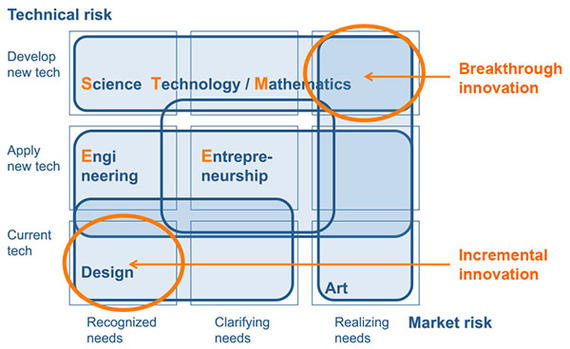Co-written by Errol Gerson
Today's university students are faced with some of the toughest challenges in the history of humankind and yet, our current educational system may not be well positioned to adequately prepare them for meeting the challenges of this increasingly inter-connected world economy.
Government sees the STEM disciplines (Science, Technology, Engineering and Mathematics) as key to our society's future success, however educators and academic institutions are now challenging this policy. STEAM is a movement championed by Rhode Island School of Design (RISD). Where they believe that "Art and Design are poised to transform our economy in the 21st Century, just as science and technology did in the last century."
Five hundred years ago there was no distinction between artists and engineers and design only became a separate discipline two centuries ago. The economic impact of engineering has outpaced design by several orders of magnitude and comparisons between design and art show the same. So, is there any reason to believe that design will really change our economy? Even the really big international players now seem to think so.
In 2004, Flextronics purchased Frog Design and over the past ten years this trend has continued. Google and Facebook now each own several industrial design firms and McKinsey and Boston Consulting Group just joined their ranks. Since 2010, big tech companies have acquired twenty-seven startups, co-founded by designers, and six large venture capital firms have invited designers onto their teams.
This new thinking opens up the theater for other disciplines to lay claim to being central to future progress and thus being included in special government funding programs. One can argue that philosophy is the root of shifting paradigms and thus critical for reframing opportunities. Or, business and entrepreneurship could argue that if needs and solutions fail to be matched up to provide viable offerings, then any catchy combination of letters combination is just pure nonsense.
In a dynamically complex world, one-liner slogans and acronyms seem to be the way we cut though the mental clutter to create positions that are easily understood and remembered. However, catchy acronyms are an unsound strategy for effectively planning our collective future. Placing the cart in front of the horse!
Thus, we offer up a map for approaching the multifaceted challenge of designing the professionals we need to address the challenges we will face.
The Market - Technology Risk matrix frames the innovation space and, based is on interviews with actual students in these disciplines, when Science, Technology, Mathematics, Engineering Design, Entrepreneurship and Art are located within the map, a comprehensive policy can be formulated based on Goal, Sustainable progress, and objectives, Locating Educational Resources, with objective metrics.
Industrial history shows that corporations are well suited for creating incremental innovations, with ninety percent of their offerings located in the lower left corner with low market and technology risk. Breakthrough innovations, especially those with large impact, have usually required government intervention, many of which have been funded though defense spending, such as, the Internet, nuclear power, electronics, jet propulsion and, more recently, autonomous driving.
Therefore, an effective cost-benefit government policy to educating our future professionals could be to emphasize disciplines located in the breakthrough innovative area and then to let the corporations handle the incremental innovation, which is what they do best. Placing the horse in front of the cart!
Definitions:
Science is Science is a systematic enterprise that builds and organizes knowledge in the form of testable explanations and predictions about the universe (J. L. Heilbron, 2003)
Technology is the practical application of knowledge to invent useful things or to solve problems (Merriam Webster)
Engineering is the work of designing and creating large structures (such as roads and bridges) or new products or systems by using scientific methods (Merriam Webster)
Special thanks to Errol Gerson for researching and co-writing this article
